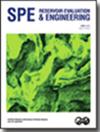用半经验模型评价致密超压天然裂缝型碳酸盐岩储层成藏
IF 1.5
4区 工程技术
Q3 ENERGY & FUELS
引用次数: 0
摘要
本文研究了墨西哥非常规致密天然裂缝型碳酸盐岩储层直井的压力响应。在4个月的时间里,在同一口井中有4个BUs,中间流动期,表明天然裂缝部分关闭。径向流在四个总线中占主导地位。这在半对数和压力导数的交叉图中可以看出。然而,公式需要一致的经验成分来匹配BU数据。采用限制孔隙间流动的半经验双重孔隙模型对4个BU试验进行了评价。基质和裂缝之间的受限流动是裂缝内部分次生矿化(胶结)的结果,这可以看作是天然的正表皮,减少了从基质流向裂缝的油流。该方法的经验部分由严重性指数(SE)提供,有助于提高BU半对数图与导数图之间的匹配。BU评估允许估计几个感兴趣的参数,包括裂缝容量(k2·h)、表皮、储层比(ω)和外推压力(p*)。结果表明,尽管存在天然裂缝,但一旦投产,裂缝往往会关闭。由此得出结论:碳酸盐岩储层致密,可能具有应力依赖性。计算出的表皮从井筒周围的改善状态变为可能由于裂缝闭合而轻微受损的状态。ω值连续增大,表明储层有由双孔隙度向单孔隙度转变的趋势。由于储层的致密性,储层超压(0.87 psi/ft),外推压力(p*)降低。然而,考虑到水库的规模,枯竭的可能性很低。该研究的新颖之处在于开发了一种易于使用的半经验试井模型,用于匹配在超压、非常规、致密、天然裂缝的碳酸盐岩储层中进行的四次测试的BU压力响应。这些测试不能与文献中现有的传统方法相匹配。本文章由计算机程序翻译,如有差异,请以英文原文为准。
Buildup Evaluation of a Tight Overpressured Naturally Fractured Carbonate Reservoir with the Use of a Semi-Empirical Model
This paper examines the buildup (BU) pressure response of a vertical well that penetrates an unconventional tight naturally fractured carbonate reservoir in Mexico. Four BUs in the same well over a period of 4 months, with intermediate flow periods, suggest partial closure of natural fractures. Radial flow is dominant in the four BUs. This is recognized in semilogarithmic and pressure derivative crossplots. However, the formulations require a consistent empirical component to match the BU data.
The four BU tests are evaluated with a semi-empirical dual porosity model with restricted interporosity flow. The restricted flow between matrix and fractures is the result of partial secondary mineralization (cementation) within the fractures, which can be visualized as a natural positive skin that reduces the oil flow from the matrix to the fractures. The empirical part of the method is provided by a severity exponent (SE), which helps improve the match between the BU semilog and derivative plots.
The BU evaluations permit estimating several parameters of interest, including fracture capacity (k2·h), skin, storativity ratio (ω), and the extrapolated pressure (p*). Results suggest that although natural fractures are present, they tend to close once the well goes on production. Thus, the conclusion is reached that the carbonate reservoir is tight and likely stress dependent. The calculated skin goes from an improved condition around the wellbore to slightly damaged conditions, probably due to fracture closure. The value of ω increases continuously, suggesting a tendency of the reservoir to move from dual to single porosity behavior. The reservoir is overpressured (0.87 psi/ft) and the extrapolated pressures (p*) decrease because of the tight characteristics of the reservoir. However, given the large size of the reservoir, the likelihood of depletion is low.
The novelty of this study is the development of a new easy-to-use semi-empirical well testing model for matching the BU pressure response of four tests performed in a well that penetrates an overpressured, unconventional, tight, naturally fractured carbonate reservoir. The tests could not be matched with conventional methods currently available in the literature.
求助全文
通过发布文献求助,成功后即可免费获取论文全文。
去求助
来源期刊
CiteScore
5.30
自引率
0.00%
发文量
68
审稿时长
12 months
期刊介绍:
Covers the application of a wide range of topics, including reservoir characterization, geology and geophysics, core analysis, well logging, well testing, reservoir management, enhanced oil recovery, fluid mechanics, performance prediction, reservoir simulation, digital energy, uncertainty/risk assessment, information management, resource and reserve evaluation, portfolio/asset management, project valuation, and petroleum economics.

 求助内容:
求助内容: 应助结果提醒方式:
应助结果提醒方式:


